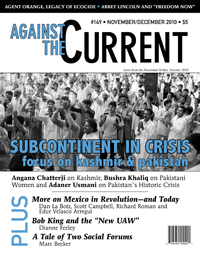Against the Current, No. 149, November/December 2010
-
After the Democrats' Debacle
— The Editors -
Race and Class: What About the Working Poor?
— Malik Miah -
Reflections on October 7th
— Wes Strong -
Resisting Agent Orange
— Michael Uhl -
Bob King and the "New" UAW
— Dianne Feeley -
Capital's War on the People
— Ismael Hossein-zadeh -
A Tale of Two Social Forums
— Marc Becker - Subcontinent in Crisis
-
Pakistan Women's Voices
— an interview with Bushra Khaliq -
After the Floods, the IMF
— Adaner Usmani -
Kashmir: A Brief Background
— David Finkel for the ATC Editors -
Kashmir: A Time for Freedom
— Angana Chatterji - The Mexican Revolution at 100
-
1810, 1910, 2010 and Mexican Labor
— Richard Roman and Edur Velasco Arregui -
After Oaxaca's Popular Rebellion
— Scott Campbell -
U.S. Socialists and the Mexican Revolution
— Dan La Botz - Reviews
-
Chronicle of a Labor Victory
— Freda Coodin -
The Long War at Staley
— Dianne Feeley -
Analyzing the Crash
— Jon Amsden - In Memoriam
-
Abbey Lincoln and Freedom Now
— Connie Crothers
David Finkel for the ATC Editors
KASHMIR WAS DIVIDED between India and the newly created Pakistani state in the chaotic division of the Indian subcontinent in 1947-48, with little reference to the wishes of Kashmir’s people. The larger part is occupied by India, with a volatile “Line of Control” separating it from the Pakistan-administered zone. The formal name of Indian-occupied Kashmir is Jammu and Kashmir; the Pakistan-controlled region is known as the Northern Areas (Gilgit-Baltistan) and Azad Kashmir. The territory’s largest city is Srinagar.
While resistance to Indian control historically has sometimes taken the form of armed militancy with Pakistani backing, as in the 1990s, since 2008 a large-scale popular movement has erupted. In the era of the “war on terror,” U.S. policy has been indifferent toward India’s violent repression of Kashmir’s majority Muslim population. Although the complexities of the long running Kashmir crisis have been daunting for outside observers and for the international left — which sympathizes with people’s aspirations for self-determination — it is high time to take seriously the Kashmiri struggle for freedom from an oppressive occupation.
ATC 149, November-December 2010

